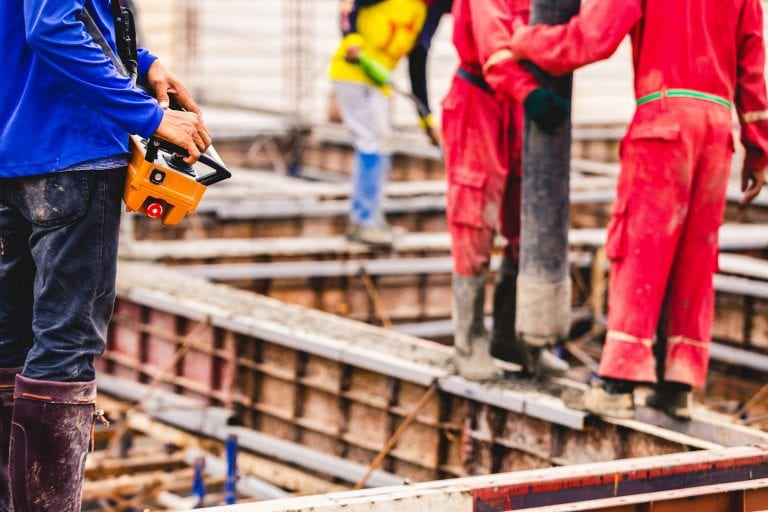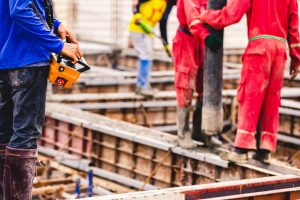Anyone who works around big, heavy concrete slabs should be aware that their lives are in perpetual danger. This goes out not just to concrete subcontractors and their teams but also to the construction workers who will work around concrete structures for quite a while. From start to finish, concrete slabs have the potential to cause severe harm to those around them.
While it’s important to know the basic safety precautions of working with concrete, the bare minimum is not enough. There are additional safety hazards to worry about, as dry and wet concrete can cause significant damages.
So today, we will share some essential safety precautions to take seriously so that concrete subcontractors can ensure the safety of their crew members at the site.
Required Safety Rules When Working With Concrete
Everyone who works with concrete should be aware of the required safety precautions by Occupational Safety and Health Administration (OSHA), including wearing gloves and safety glasses during a concrete pour, as well as have an eyewash station nearby. As stated above, these basic safety rules are not enough, and there are other crucial safety precautions to take when working with concrete.
But we will give you the general safety rules you should know about. So here’s a quick overview of the noteworthy hazards when working with concrete:
- Mixing risks. Concrete dust can cause breathing problems. Concrete is composed of small pieces of stone, called aggregate. When these stones are mixed with cement, the tiny particles of aggregate dust can be dispersed into the air and inhaled.
- Pouring risks. Concrete can be slippery until it dries. If any bit of the wet mixture gets on a worker’s boots or the ground, it can cause the worker to slip and fall. Furthermore, the alkaline properties of wet cement can be caustic. If the cement splashes on the skin and isn’t removed quickly, the chemicals in the mixture can lead to third-degree burns.
- Drying risks. Concrete slabs can weigh more than 800 pounds and are at risk for tipping, shifting, and falling on those around them.
Almost every job that you can have as a concrete subcontractor or construction worker carries a possibility of working with concrete, which ultimately increases your chances of sustaining serious injuries.
General Concrete Dangers When Working with Concrete
Concrete construction accidents can happen in many different ways. When working on or around concrete, you need to be continually vigilant to ensure you work as safely as possible. Some common mishaps that can cause concrete construction accidents include:
- Workers falling onto concrete slabs.
- Workers being crushed by slabs falling from cranes or forklifts.
- Workers getting pinned between concrete slabs.
- Workers suffering heatstroke while cleaning truck mixer drums.
- Workers being impaled on rebar sticking out of concrete slabs.
- Workers getting caught in concrete mixers or covered with concrete.
- Workers being burned or blinded by concrete chemicals.
- Workers suffering back injuries from lifting heavy concrete slabs.
A few of these accidents are pure chance accidents, and there is nothing that can be done to prevent them. However, the much more common scenario is that these incidents—and the injuries that result—are the direct result of someone else’s negligence.
Dry and Wet Concrete Dangers
I – Dry Concrete
Dry concrete can irritate the eyes, nose, and throat, as well as the skin. When dry concrete makes contact with skin, it can result in minor irritation to cracking of the skin. Those who are exposed to silica dust, a main component in dry concrete, for long periods of time are at risk for developing silicosis or lung cancer.
To ensure dry concrete does not cause any harm or damage, it’s important to follow the following safety precautions:
- If you get concrete dust in your eyes, immediately flush eyes out at the eyewash station.
- After working with dry concrete, wash your hands with soap and water thoroughly to avoid skin damage.
- To avoid developing serious illnesses, wear an N-95 respirator to decrease the inhalation of dust.
- When taking a break on a construction site, eat or drink in dust-free areas or inside to avoid ingesting any cement dust.
II – Wet Concrete
When working with wet concrete, it’s true that the risk of silica exposure decreases, but there are still many hazards to be aware of. For example, an overexposure of wet concrete can result in many adverse health effects, and the following safety precautions should be taken seriously:
- To protect your skin and eyes, wear alkali-resistant gloves, long sleeves and long pants to keep skin covered, waterproof boots, and eye protection. It is good practice to keep extra gloves and safety glasses at construction sites.
- When wet concrete makes contact with skin, it can result in severe chemical burns. If this happens to you, wash the contaminated skin areas with cold water and non-alkaline soap as soon as possible to prevent skin damage.
- If wet concrete somehow gets on your face or in your eyes, use the eyewash station for 15 minutes and consider going to the hospital for more treatment.
Construction Site Safety Tips When Working With Concrete
Considering the amount of risk involved when dealing with concrete, it’s no surprise that the Occupational Safety and Health Administration has mandated specific safety standards for construction workers. These mandates include:
Protect Your Skin
Contact with wet or unhardened concrete mortar cement, or cement mixtures can cause skin irritation, severe chemical burns up to third-degree, or serious eye damage. Cement burns are extremely painful and disfiguring. Unfortunately, the pain is not felt for hours and may not be severe for days. By the time medical attention is sought, a third-degree burn often has occurred.
Frequent exposure may be associated with irritant and/or allergic contact dermatitis. Wear water-proof gloves, a long-sleeved shirt, full-length pants, and proper eye protection when working with these materials. If you have to stand in wet concrete, use water-proof boots that are high enough to keep concrete from flowing into them.
Wash wet concrete, mortar, cement, or cement mixtures from your skin immediately. Flush eyes with clean water immediately after contact and seek immediate medical attention. In-direct contact through clothing can be as serious as direct contact, so promptly rinse out wet concrete, mortar, cement, or cement mixtures from clothing. Seek immediate medical attention if you have persistent or severe discomfort.
Protect Your Head
Always wear an approved hard hat when on a construction job site. Be sure to take proper care of your hard hat. Do not punch holes into it and don’t store or carry it on the rear window shelf of a vehicle as the sunlight and extreme heat may weaken it. Do not wear the hat backward or when it is damaged. Don’t wear a steel hard hat, which can conduct electricity.
Protect Your Eyes
Wear shatterproof safety eye protection at all times to keep cement, flying particles, dust and toxic fumes out of your eyes. Don’t wear contact lenses on the job. Chemicals, gases or dust may get under them and irritate or damage the eyes.
Protect Your Ears
There is no cure for noise-induced hearing loss. To avoid damage, wear self-fitting earplugs made of waxed cotton, foam or glass fiber wool which are available in most drug stores. Preformed or molded earplugs that are fitted to your ears specifically can also be purchased from a professional. Do not use disposable earplugs more than once
Protect Your Feet
To protect your feet from falling objects, crushing hazards or punctures from sharp objects like rebar or tie wire, wear steel-toed safety boots. If you have to stand in wet concrete, wear waterproof rubber boots.
Protect Your Back
Back problems from overexertion are a common construction site injury. Do not lift too much! Keep your back straight, knees bent and the load close to your body when lifting to minimize strain. Lift with your legs, not your back. Never twist your body when carrying a load; pivot your feet, not your spine. When a load is too heavy, ask for help. Concrete weighs between 120 and 150 pounds per cubic foot which is a lot of weight in a small volume. Use wheeled carts whenever possible and don’t overload it. Make sure the path is clear of tripping, slipping or falling hazards.
Protect Your Respiratory System
Employers must provide their workers with face masks or ventilators when there is a threat of cement-related air pollution on site.
Hazard communication.
In addition to warning their employees of the potential risks, employers must also provide adequate warning signs and guards when cement hazards are present on the construction site. It is also important to warn others of any concrete dangers immediately which is possible through a concrete subcontractor software like Pro Crew Schedule where communication is fast. Plus, you can also attach photos of the danger zone so others can easily recognize it when they pass through it.
Unfortunately, despite the safety mandates from OSHA, many business owners fail to take all the necessary precautionary steps to protect their employees. While the liability of a workplace accident may vary depending on the circumstances, the general rule is that if someone else’s negligence caused an injury, the injured person deserves compensation. So as a concrete subcontractor or a general contractor, see to it that these basic safety precautions are observed at the construction site to avoid delays and claims.





